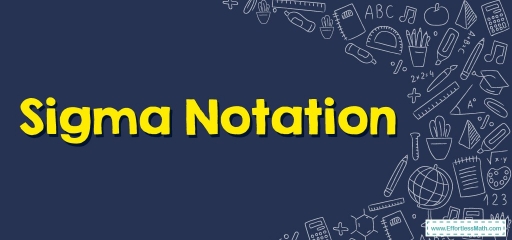How to Expand Sigma Notation?
The summation notation is useful for writing the sum of several or more phrases that follow a particular pattern. In this step-by-step guide, you will become more familiar with sigma notation along with how to write it.

The symbol \(Σ\) (Sigma) is generally used to indicate a sum of multiple terms. This symbol is generally associated with an index that varies to encompass all terms that must be considered in the sum.
Related Topics
A step by Step guide to Sigma notation
The sigma notation is the simplest way to write a very large set of elements in a sequence in a simple way. We know that a sequence is a set of terms that follow a pattern, and the Sigma notation is used to represent the sum of such elements.
This is also known as summation notation because it represents a sum. The terms that are being added in Sigma notation are called “summands” or “addends”.
In general, the summation notation is used to represent the sum of elements of a sequence [\({a_i}]^n_{i=1}\).
Summation symbol
The summation symbol is \(∑\) which is pronounced as “sigma”. This is one of the Greek alphabets. This sigma symbol is also known as the “capital sigma”. The summation notation written using the sigma symbol is also known as a “series” as it represents a sum.
writing sigma notation
Here are the steps in detail for writing the sum of terms as a summation:
- Find the general term of the terms of the sum. If the sequence of expressions is arithmetic or geometric, we can use the general term formula of the respective sequences. Otherwise, we will find the general formula by examining and observing.
- Select some letters of the alphabet (preferably lowercase letters) as the index. The common letters we choose for the index of summation are \(i\) or \(k\).
- Observe the sequence and determine the first value and the last value of the index.
- Finally, use the sigma symbol to write the sigma notation.
Expanding summation notation
Expanding the summation notation is just the opposite process of writing it. Here are the steps for writing the same.
- Replace each index value (starting from the first to the last and increasing it by \(1\) every time) in the general phrase.
- Place a plus symbol between all such terms obtained from the last step.
Properties of Sigma notation
- If there is a constant that is multiple in the general term, then we can write it out of the notation \(\sum_ {i=1}^n ka_i=k\sum _{i=1}^n a_i\), where \(k\) is a constant.
- The summation notation can be split along with addition or subtraction. i.e., \(\sum_ {i=1}^n\left(a_i\pm b_i\right)=\sum _{i=1}^n a_i\pm\sum _{i=1}^nb_i\)
- The sigma notation cannot be split along the multiplication or division. i.e., \(\sum_ {i=1}^n\:\left(a_i b_i\right)\ne \sum_ {i=1}^n a_i \sum _{i=1}^n b_i\) and \(\sum_ {i=1}^n \frac{a_i}{b_i}\ne \frac{\sum_ {i=1}^n a_i}{\sum_{i=1}^n b_i}\).
- \(\sum _{i=1}^n1=1+1+1+\:…+1\) (\(n\) times) \(= n\).
- \(\sum _{i=1}^n0=0+0+0+\:…+0\) (\(n\) times) \(= 0\).
Sigma Notation – Example 1:
Write the following sum in sigma notation: \(5 + 10 + 20 + 40 + … + 1280\).
Solution:
Every term is obtained by multiplying its previous term by \(2\). So it is a geometric sequence with a common ratio \(r=2\) and first-term \(a = 5\). So its general term is:
\(a_n= ar^{n-1} = 5(2)^{n-1}\).
Now, let \(5(2)^{n-1}= 1280\)
Dividing both sides by \(5\),
\((2)^{n-1} = 256\)
\(2^{n-1} = 2^8\)
\(n-1 = 8\)
\(n = 9\)
So the given sum can be written as \(\sum _{i=1}^95\left(2\right)^{n-1}\).
Exercises for Sigma Notation
solve each expression.
- \(\color{blue}{\sum _{k=1}^43k}\)
- \(\color{blue}{\sum _{n=2}^5n^2}\)
- \(\color{blue}{1 – 10 + 100 -1000 + 10,000}\)
- \(\color{blue}{\frac{1}{4}+\frac{3}{8}+\frac{7}{16}+\frac{15}{32}+\frac{31}{64}}\)

- \(\color{blue}{30}\)
- \(\color{blue}{54}\)
- \(\color{blue}{\sum _{k=1}^5\:\left(-10\right)^{k-1}}\)
- \(\color{blue}{\sum _{n=1}^5\:\frac{2^n-1}{2^{n+1}}}\)
Related to This Article
More math articles
- How to Unravel One-to-One Functions
- 7th Grade STAAR Math Practice Test Questions
- How to Solve Real-Life Puzzles: Word Problems on Adding and Subtracting Fractions with Like Denominators
- Patterns: Numbers
- Number Properties Puzzle – Challenge 13
- Best Books for Students Preparing for the SAT Math Test
- 15 Geniuses who changed the world of mathematics forever
- Top 10 4th Grade MEAP Math Practice Questions
- The Rules of Integral: Complex Subject Made Easy
- Top 10 SIFT Math Practice Questions





























What people say about "How to Expand Sigma Notation? - Effortless Math: We Help Students Learn to LOVE Mathematics"?
No one replied yet.